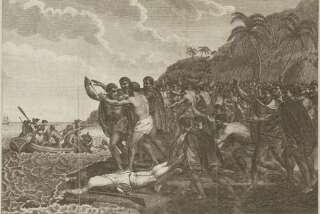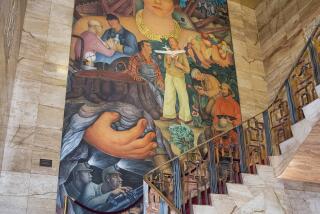Following in the Wake of Cabrillo : Biographer’s Study of Pacific Explorer to Be Published
An eight-year quest to trace the life of the first European to explore the California coast and discover San Diego Bay has resulted in a biography of Juan Rodriguez Cabrillo which will be published this fall by the Huntington Library at San Marino.
Harry Kelsey, chief curator of history at the Natural History Museum of Los Angeles County, is the author of “Cabrillo,” the story of the explorer whose discoveries provide the oldest written record of man on the West Coast.
Cabrillo was one of the original conquistadors who served with Hernando Cortes in the Spanish campaign that conquered Aztec Mexico between 1519 and 1521. Bernal Diaz, a chronicler and participant later recalled Cabrillo as an experienced soldier and crossbowman as well as a qualified mariner.
In 1542, Cabrillo left the port of Navidad on the west coast of Mexico with three ships, according to Kelsey. Other historians have claimed that there were only two vessels. The author writes that a smaller one, the San Miguel, could have been the first to enter San Diego Bay on Sept. 27 of that year, for Cabrillo named it San Miguel on his chart.
Discovery of San Diego
Bartolome Ferrelo, Cabrillo’s chief pilot, kept a journal of the voyage. It was written in the third person, describing the events of Sept. 27 and 28, 1542, when they discovered San Diego:
“On this day they saw on the mainland some great smokes. The country appears to be good with large valleys. Inside, there are some high sierras. After anchoring, they went ashore where there were some people, three of whom awaited them, while the rest fled. To these some presents were given . . . That night some went ashore from the ship to fish with a net, and it seems that there were some Indians who commenced to shoot arrows at them and wounded three men . . . The people were well built and large and go about covered with the skin of animals . . .”
The natives’ lack of hospitality failed to deter the Spaniards. By distributing some shirts and possibly other trinkets, they found the Indians more tractable.
Kelsey became interested in Cabrillo when his department was preparing exhibits for its Lando Hall at the museum which would be devoted to four centuries of California’s history, from 1540 to 1940.
“The late Jack Alexander was our model maker,” Kelsey said. “He suggested we do a small replica of Cabrillo’s flagship, the San Salvador. I volunteered to do the research on how the ship was constructed. During my research, I did find a volume published in the late 16th Century describing how Spanish ships of the era were designed. At the same time, I became increasingly interested in Cabrillo. What kind of a man was he--good, bad or otherwise?
“Many historians have said he was Portuguese. Perhaps successive writers have accepted as fact statements made in early chronicles. I discovered he was born in Spain, probably around 1498 or 1500.”
One of Kelsey’s primary sources was the Archives of the Indies at Seville, Spain, which is the official repository of all the records of the Spanish conquests in the New World.
“The building was constructed in the 16th Century,” he said, “and it’s not heated. While working there, I nearly froze. I was seated at a table wearing a scarf, overcoat and gloves with the fingers cut off so I could take notes. I was also learning paleography, the art of deciphering ancient writings. The scribes during the 1500s used different spellings and abbreviations. The quality of their paper was good, but sometime the ink had faded. I was also teaching myself Spanish as I went along.”
The search for additional information on the men who forged an empire for Spain in the New World led Kelsey to a monastery 150 miles west of Madrid. “It’s a shrine called Our Lady of Guadalupe,” he said. “Seamen would make pilgrimages there after a voyage, praying before a wood statue of the Virgin Mary. Monks of the Franciscan Order live there today. I found records of some of the conquistadors who had been there. Cortes was one. It was customary to leave a gift. The conqueror of Mexico donated a few jewels. It seemed a small bequest, considering the treasures he had acquired.”
The National Library at Madrid contained numerous maps and manuscripts relating to Spanish explorations. It was here Kelsey found descriptions of shipbuilding during the 16th Century. He described Cabrillo’s flagship as a galleon of 200 tons, about 100 feet long with a high sterncastle. It also had a slim hull, about 25 feet of beam and a square stern.
A vessel the size of the San Salvador would have been equipped with two or three small pieces of artillery. The soldiers would have been armed with crossbows and arquebuses. The latter was an early type of portable gun fired by a matchlock and trigger, and usually supported on a forked rest during firing.
Crew Ate Well
Judging from Kelsey’s account, the crew ate well during the voyage of discovery. “The ships carried enough supplies to last two years. They loaded such staples as wine, olive oil, hard bread, salted meat and salt fish. This was to be supplemented by fresh fish and food gathered ashore or traded with the natives along the way.”
A typical meal the seamen might expect for a midday repast would consist of biscuits, a few cloves of garlic to add a little zest to the meal, and sardines or cheese with oil and vinegar for flavor. Each man received three mugs of wine. Sunday and Thursday there was salt meat. Additionally, there was cod or some other fish, beans, peas or cabbage and soup. The officers and surgeon dined alone, generally enjoying better fare.
Kelsey continued his research at the Bancroft Library at UC Berkeley, which has considerable material on this early California period. The Honnold Library at the Claremont Colleges has a collection of rare maps and documents that were acquired by Henry Wagner, an expert on 16th Century navigation along the California coast. The Huntington Library has a rich collection of early printed material by Spanish writers of the 16th Century.
“It was June 27, 1542, when Cabrillo lead his fleet from the port of Navidad,” Kelsey said. “Their mission was to explore the coast of New Spain. At that time, they knew little of the geography of the Pacific Coast. The pilots had studied and copied all the available charts from prior expeditions by Cortes, Bolanos, Alarcon and Ulloa. Cabrillo, like the others, was under the impression that if they sailed northwest along the coast they would reach China. Japan was thought to be an island off the coast. These mariners had no conception of how vast a distance it was across the Pacific.”
The Spaniards crossed the Gulf of California, anchoring off the point of Lower California, noting it in their logs. This was one of the earliest uses of the word California to designate a geographic location for the Pacific coast which was covered with snow. They called the mountains the Sierras Nevadas--snowy mountains. This is now the Santa Lucia range.
At least 25 Indian towns were given names along the California coast. The natives were friendly. Ferrelo wrote: “They go dressed in skins and have very long hair tied up with some long cords. Inserted between the hair and these cords are daggers made of flint, bone and wood.”
Cabrillo was later injured in a fall and died. Where the accident took place, the exact injuries and his burial site have been disputed by historians. As Kelsey has pieced the story together, there was an altercation with the Indians on Santa Catalina Island. On Christmas Eve of 1542, some of the soldiers went ashore and were attacked by the natives. Cabrillo determined to rescue his men, rowing ashore with a relief party.
“As he jumped from the boat, one foot struck a rocky ledge and he splintered a shinbone,” Kelsey said. “One account says he broke an arm close to the shoulder. Another says he broke both an arm and a leg. Regardless, Cabrillo developed gangrene, something the ship’s surgeon with the limited medical knowledge of the era was unable to treat. Cabrillo died, and I believe he was buried on Catalina Island, although his grave has never been located.”
A dying Cabrillo turned over his command to the chief pilot, Bartolome Ferrelo, charging him to discover as much as possible of all the coast. Ferrelo followed orders, sailing north, possibly as far as Oregon. With Cabrillo gone, the expedition began to lose its driving force, and supplies were running out. Ferrelo brought the ships back to Navidad on April 14, 1543.
Don Antonio Mendoza, the king’s viceroy in Mexico, considered the expedition a failure. Land meant little to the Spaniards who had overrun Mexico, Central and parts of South America. Cabrillo had failed to reach China. Money and men had been wasted in a fruitless effort to find new riches.
More to Read
Sign up for Essential California
The most important California stories and recommendations in your inbox every morning.
You may occasionally receive promotional content from the Los Angeles Times.










